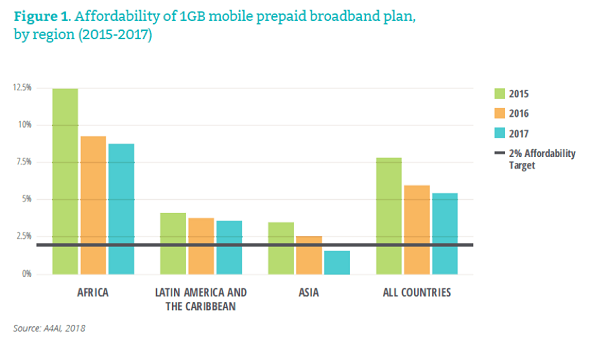Despite expectations to the contrary, internet access remains increasingly unaffordable in many areas, according to new research. The gap is growing, not closing. What does this mean and how can we change the situation?
Find out what we can do.
It is not just WTL that thinks this: affordable access to the internet is a key objective of the UN SDGs (Strategic Development Goals – 9c), so it has great prominence in policy and investment decisions. According to the latest annual report from A4IA, the Affordable Internet Foundation, some good progress has been made. By 2019, it is expected that 50% global penetration of internet access will be reached.
However, this figure was actually expected to have been surpassed in 2017, so it’s now two years late. Worse, the rate of growth has slowed down dramatically. What’s gone wrong? Well, it seems that a key obstacle is affordability. A4IA has a clear affordability target in mind. It believes that “1 for 2” is key – that is, the ability to purchase 1 Gb of data for no more than 2% of the average monthly income. Figure 1, taken from the report, shows how far we are from this target.
This means that a huge gap remains – not only in countries, but also between genders. What’s abundantly clear from the ongoing research is that market forces alone cannot resolve the problem. As we at WTL have been saying for some time and also according to A4IA, good policy is the key tool for reducing connectivity costs and “enabling more opportunities for affordable access”. Instruments that have been shown to be effective include USAFs (Universal Service and Access Funds) and intelligent spectrum policies, but these cannot work without ensuring an effective flow of investment, to the right areas. Investing in areas with higher income existing or potential customers doesn’t close the gap – it just gives more to those that already have access.
So, not only are the right policy tools required, they must be pursued in the right places. What can be done about this? WTL suggests there are three problems to address. First, the cost of infrastructure needs to be reduced. Second, infrastructure needs to be used to extend existing footprints to go beyond the areas in which higher-income customers are concentrated. Third, entirely new areas that are beyond the reach of existing networks need to be targeted, as a matter of urgency.
The first problem can be solved by the use of solutions such as Vivada, which dramatically lowers the cost of providing coverage in general. Second, “spur” or branch networks need to be built that expand existing coverage slots, using lower-cost solutions. In other words, hotspots that gradually fill in gaps around existing deployments to allow simple but effective expansion. We can call these areas brownfield coverage areas, because they may neighbour or be close to existing assets.
As for the third, this is perhaps the greatest challenge of all. Of course, affordable solutions are needed, which can be deployed as standalone networks in isolated regions (with mostly lower-income customers). In this case, we would also add that combining communications services with others that are enabled by connectivity, such as mobile payments, agricultural information services, and IoT monitoring capabilities, can help boost the business case for such deplyments. But, we also need instruments such as spectrum and infrastructure sharing to enable equal access to such deployments. Interestingly, A4IA’s research has shown that countries which support infrastructure sharing generally perform better in affordability indices.
There’s much more, and we’ll bring you further analysis in future bulletins, but the situation is clear. Progress has been made, but not enough and the rate of progress is slowing. Market forces have been unable to address the situation in isolation. Things need to change and, to achieve this, positive action is required. The figures are startling and should raise alarm bells. Africa, in particular, is suffering due to the lack of affordable access.
That’s why WTL has been both investing in affordable technology solutions and why we have been passionately advocating instruments such as spectrum sharing. We have the technical solutions – and expertise to deliver them, whether as branches to existing infrastructure or to entirely new locations – but we need to work together to shape the market and to ensure effective implementation of policy.
If you are involved in projects to deliver affordable internet access, why not get in touch to see how we can help – or meet us at MWC to discuss your plans?


